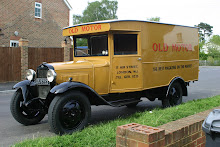The first thing we needed to do was take a good look at the bodywork as a number of things were bothering me. These primarily being a strip of 2" flat stock that was fitted all the way around the saloon just above the windows in place of the facia, the replacement roof hoops and the reported long term defect of a twist in the front bulkhead.
Starting with the flat stock, we decided to take it out to see what horrors it was hiding and if it was holding it all together! Thankfully the latter was not the case, although a percentage of the woodwork underneath is not in the best of health. The flat stock also prevented the front bulkhead facia from being fitted properly, it would thus require modification. Bearing in mind this is an original piece it is better to correct the underlying problem than add to it.
The next item were the roof hoops, the majority of which have been replaced leaving only 2 original ones upon the vehicle. The quality of the replacement ones is of a very poor standard with a hap hazard internal profile that varies from hoop to hoop. The sticks should also be flitched with metal internally but for whatever ever reason this had not been done and the flitch plate has just been bolted to the outside of the hoops. Although this in itself does not affect the strength, the hoops need addressing so this shall also be rectified.

You can see the flitch plate painted cream on the outside of the hoops in the above photo.
The exterior of the roof looks straight with its leathercloth covering below.
The exterior of the roof looks straight with its leathercloth covering below.

However this is not how Weymann designed the roof, it was originally a taught canvas covering over the framework. The leathercloth was thus removed to reveal that it had been glued onto a not very well laid base of aluminium sheet and mountains of filler, which when taken up showed a very uneven roof framework.

The grey coloured wood towards the front of the photo running lengthwise being the only original pieces. You can also see that the front bulkhead top rail has had a piece let in on the right hand side of the picture.
Which neatly brings us on to the story that the coach has a twist in the front bulkhead. Now was the perfect opportunity to ascertain what the actual problem is. With all the interior panels now removed we can clearly see where the problem lies. All of the horizontal pieces across the front bulkhead have been repaired with pieces being let in from the N/S. Some of these replacement pieces are not dimensionally the same as the timber they are replacing hence a slight misalignment.
Which neatly brings us on to the story that the coach has a twist in the front bulkhead. Now was the perfect opportunity to ascertain what the actual problem is. With all the interior panels now removed we can clearly see where the problem lies. All of the horizontal pieces across the front bulkhead have been repaired with pieces being let in from the N/S. Some of these replacement pieces are not dimensionally the same as the timber they are replacing hence a slight misalignment.

Although not easy to see in the photograph above, the bottom front bulkhead rail changes thickness in the center of the picture just after the second grey upright. Unbelievably the splice is just over the metal bracket that adjoins the chassis. We can only make educated presumptions as to the reason behind this, but it is likely at some point GW has sustained damage to the N/S front. It is most likely from a traffic accident, but could have happened due to bomb damage when it was used during the second world war. Due to the photograph below taken on Epsom Downs at the Derby in 1949, by Alan Cross, we know the rebuild work was carried out prior to this point.

It was then felt as we had dismantled this far and what we had found was not of the highest order that the remaining panels should be removed to assess the rest of the framework. This revealed some more damage repair work and interesting replacement.

So all in all the state of the body framework has clearly become very apparent and has helped in making the decisions for the best way forward.

